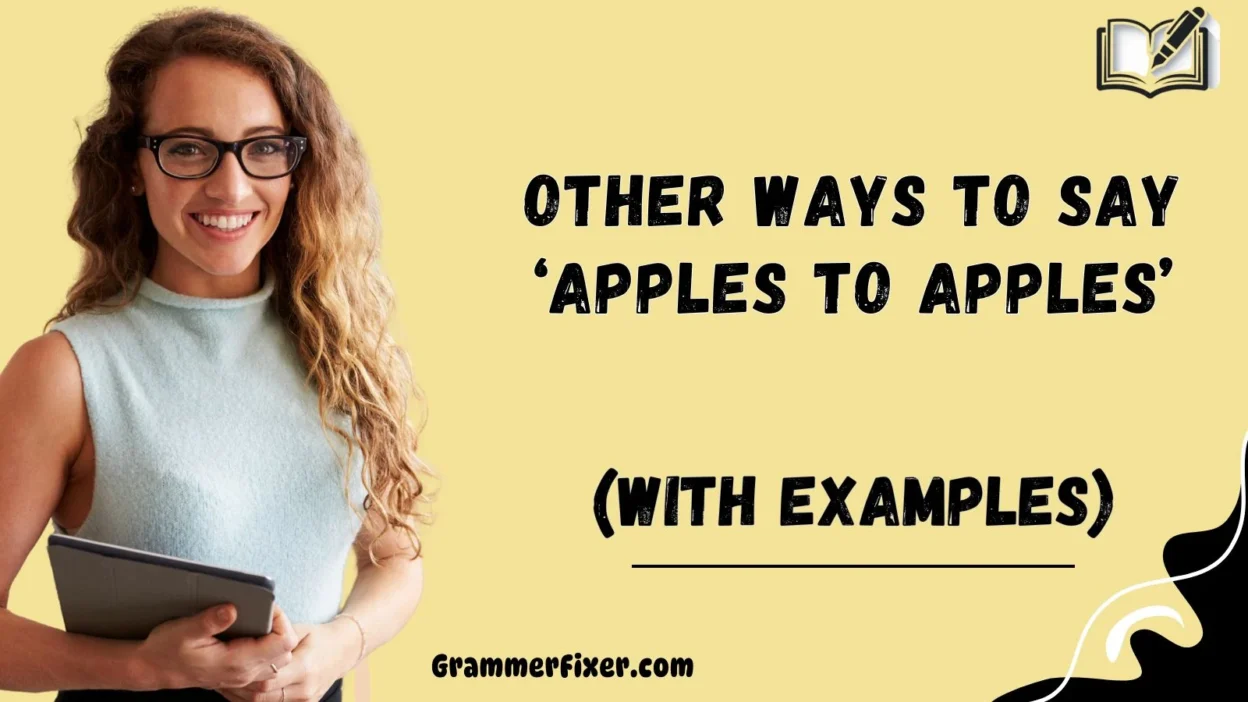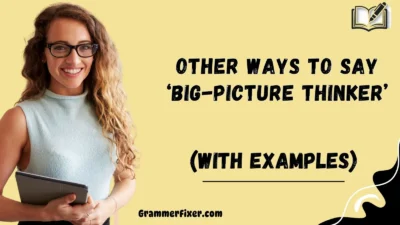Finding the right words can transform the way we connect. The phrase “apples to apples” is often used in professional, academic, and personal settings to highlight a fair comparison, but it can sometimes feel casual or overused. That’s where having a list of formal synonyms and alternatives comes in handy. Choosing the right expression can add warmth, care, and precision to your communication, ensuring your message feels thoughtful, professional, and meaningful.
Below, you’ll find 30 formal alternatives to the phrase “apples to apples”, along with their meanings, detailed explanations, examples, best uses, and tone guidance.
What Does “Apples to Apples” Mean?
The phrase “apples to apples” means making a fair, equal, and relevant comparison between two or more things that share similar conditions, factors, or contexts. It emphasizes that the items being compared should be equally measured and judged to avoid confusion or unfairness.
When to Use “Apples to Apples”?
You can use “apples to apples” when:
- Comparing prices, services, or products in business.
- Evaluating candidates or performance under the same criteria.
- Explaining analysis or research where equal conditions matter.
- Clarifying fairness in discussions or decisions.
Is It Professional/Polite to Say “Apples to Apples”?
While the phrase is widely understood and polite, it is also seen as informal and sometimes cliché in professional writing or international business contexts. That’s why using formal alternatives can help you sound more precise and polished.
Pros or Cons of Saying “Apples to Apples”
Pros:
- Easy to understand.
- Works well in casual conversations.
- Adds relatability.
Cons:
- Can feel overused or unprofessional.
- May sound colloquial in formal writing.
- Not always clear in multicultural or international contexts.
1. Like-for-Like Comparison
Meaning: Evaluating two things under the same conditions or factors.
Detailed Explanation: This phrase is often used in business and financial contexts when comparing prices, products, or services that are similar in nature.
Scenario Example:
- “We need to conduct a like-for-like comparison of vendor proposals before making a decision.”
Best Use: Professional reports, financial discussions, industry benchmarking.
Worst Use: Everyday casual conversations, such as discussing personal preferences (“Let’s do a like-for-like comparison of pizza toppings”) — it will sound stiff and unnatural.
Tone: Formal, precise, business-oriented.
2. Direct Comparison
Meaning: A straightforward evaluation between two or more items.
Detailed Explanation: Highlights the act of placing items side by side to measure similarities or differences.
Scenario Example:
- “This chart allows for a direct comparison between Q3 and Q4 results.”
Best Use: Presentations, academic research, reports.
Worst Use: Friendly or creative discussions (e.g., comparing art styles or personal tastes) — may sound too rigid and technical.
Tone: Neutral, professional, clear.
3. Equivalent Assessment
Meaning: An evaluation where two or more items are judged as having equal status or conditions.
Detailed Explanation: Common in academic, technical, and HR contexts, this term stresses fairness and a balanced judgment based on consistent criteria.
Scenario Example:
- “Applicants will undergo an equivalent assessment to ensure the process is unbiased.”
Best Use: HR evaluations, academic testing, legal or compliance reviews.
Worst Use: Light, everyday comparisons (like choosing between coffee shops) — the phrase will feel too formal and heavy.
Tone: Highly formal, impartial, and fairness-focused.
4. Comparable Evaluation
Meaning: A structured review to determine whether items are similar enough to measure fairly.
Detailed Explanation: Often used in business performance analysis or financial auditing, it signals a professional and careful assessment.
Scenario Example:
- “The board requested a comparable evaluation of last year’s budget against this year’s projections.”
Best Use: Financial reviews, project audits, corporate reports.
Worst Use: Informal situations (like comparing two movies with friends) — comes across as unnecessarily formal.
Tone: Formal, professional, analytical.
5. Fair Comparison
Meaning: A comparison made with equal and unbiased conditions.
Detailed Explanation: A softer alternative that balances professionalism with relatability, highlighting the idea of justice and transparency.
Scenario Example:
- “To ensure a fair comparison, both candidates were given the same interview questions.”
Best Use: Professional communication, HR, education, and multicultural contexts where fairness is essential.
Worst Use: Highly technical or data-heavy documents, since the term may sound too casual or vague.
Tone: Warm, approachable, yet professional.
6. Valid Comparison
Meaning: A comparison that is accurate, relevant, and logically sound.
Detailed Explanation: Highlights the validity of factors considered in the comparison, ensuring that the results are credible.
Scenario Example:
- “It would not be a valid comparison to judge software packages without considering security features.”
Best Use: Academic writing, research analysis, scientific or business contexts.
Worst Use: Everyday chats (“This pizza vs. that pizza”) — sounds unnatural and overly academic.
Tone: Technical, precise, logical.
7. Equal Basis
Meaning: Making comparisons on the same level of standards or conditions.
Detailed Explanation: Implies a level playing field, ensuring both sides have an equal opportunity to be judged.
Scenario Example:
- “Both proposals will be reviewed on an equal basis to eliminate bias.”
Best Use: Contract negotiations, HR, legal documents.
Worst Use: Casual remarks or personal conversations — may feel too stiff and abstract.
Tone: Formal, impartial, and structured.
8. Side-by-Side Comparison
Meaning: Placing two or more items next to each other to analyze similarities and differences clearly.
Detailed Explanation: A very visual and practical phrase, often used in reports, presentations, and product reviews.
Scenario Example:
- “This graph provides a side-by-side comparison of Q2 and Q3 sales.”
Best Use: Presentations, data visualization, marketing and product reviews.
Worst Use: Formal legal or academic texts — the imagery may feel too casual for strict documents.
Tone: Clear, approachable, slightly informal but still professional.
9. Benchmarking
Meaning: Measuring items against industry standards or best practices.
Detailed Explanation: Used in business, technical, and corporate settings, this term emphasizes standardized measurement for improvement.
Scenario Example:
- “We’re benchmarking our service quality against top industry providers.”
Best Use: Business reports, corporate presentations, technical analysis.
Worst Use: Informal conversations — saying “Let’s benchmark our dinner choices” sounds awkward and forced.
Tone: Professional, technical, improvement-focused.
10. Professional Analogy
Meaning: A formal comparison using analogy to explain complex concepts.
Detailed Explanation: Effective in presentations, teaching, and business contexts to make abstract or technical ideas relatable.
Scenario Example:
- “Think of cloud storage as a professional analogy to a digital filing cabinet.”
Best Use: Training, client communication, presentations.
Worst Use: Highly technical data-driven reports — analogy may oversimplify or cause ambiguity.
Tone: Professional, explanatory, accessible.
11. Formal Equivalence
Meaning: A phrase suggesting precise equality or structured similarity between two entities.
Detailed Explanation: Often used in academic, linguistic, or legal contexts, it stresses accuracy and exactness.
Scenario Example:
- “The translation follows a principle of formal equivalence, keeping the meaning aligned with the source text.”
Best Use: Legal documents, linguistic studies, technical writing.
Worst Use: Casual conversations — it will sound overly academic and possibly confusing.
Tone: Formal, exact, detail-oriented.
12. Equal Comparison Options
Meaning: Ensuring that items are compared under balanced conditions with equal opportunities.
Detailed Explanation: A phrase that emphasizes fairness and clarity in decision-making or evaluations.
Scenario Example:
- “Both vendors were given equal comparison options during the selection process.”
Best Use: Vendor selection, HR processes, contract negotiations.
Worst Use: Light discussions (like comparing sports teams or music) — will feel too structured for casual speech.
Tone: Fair, transparent, professional.
13. Comparable Pairings
Meaning: A set of items chosen because they are similar enough to be judged together.
Detailed Explanation: Often used in business analysis or product reviews, this phrase highlights the idea of grouping like items for fair evaluation.
Scenario Example:
- “The report includes comparable pairings of software tools for better decision-making.”
Best Use: Market research, vendor analysis, technical reports.
Worst Use: Informal settings (like choosing between vacation spots) — sounds too formal and mechanical.
Tone: Professional, analytical, structured.
14. Formal Parity Comparisons
Meaning: Evaluations where equal value or status is recognized across the compared items.
Detailed Explanation: Best for academic, legal, or technical discussions, where parity and fairness need to be emphasized.
Scenario Example:
- “The study applied formal parity comparisons to ensure unbiased results.”
Best Use: Academic research, legal documents, policy analysis.
Worst Use: Everyday conversations — sounds heavy, rigid, and jargon-filled.
Tone: Highly formal, impartial, academic.
15. Similarity Replacements
Meaning: Substituting one item with another because they share similar functions or qualities.
Detailed Explanation: Works best when discussing products, services, or solutions that can replace each other.
Scenario Example:
- “The HR system offers similarity replacements for outdated manual processes.”
Best Use: Business communication, product documentation, customer service.
Worst Use: Academic or scientific writing — the phrase may sound too commercial.
Tone: Practical, functional, moderately formal.
16. Parallel Comparisons
Meaning: Placing two items side by side, emphasizing that they follow a parallel structure or function.
Detailed Explanation: This phrase is strong in strategic planning, analysis, or technical contexts, where parallelism is key to clarity.
Scenario Example:
- “The report draws parallel comparisons between Q1 and Q2 productivity levels.”
Best Use: Reports, presentations, strategic discussions.
Worst Use: Informal personal communication — may sound too stiff and structured.
Tone: Formal, analytical, precise.
17. Equivalent Alternatives
Meaning: Options or items that carry equal weight or value in a decision-making process.
Detailed Explanation: Often used when discussing replacement products, job candidates, or services that offer the same benefits.
Scenario Example:
- “Both suppliers are considered equivalent alternatives for this contract.”
Best Use: Business negotiations, HR, procurement processes.
Worst Use: Informal chats about casual choices (like food or hobbies) — sounds excessively formal.
Tone: Balanced, fair, decision-focused.
18. Balanced Examination
Meaning: A review or analysis that considers all sides fairly and equally.
Detailed Explanation: This phrase works well in contexts where objectivity and fair assessment are crucial, such as audits, evaluations, or research studies.
Scenario Example:
- “The committee will conduct a balanced examination of both proposals before reaching a decision.”
Best Use: Academic reports, audits, corporate reviews.
Worst Use: Casual or creative discussions — sounds too technical and heavy-handed.
Tone: Formal, fair-minded, neutral.
19. Formal Similarity Replacements
Meaning: Substituting one option with another based on recognized similarity in function or value.
Detailed Explanation: Useful in technical documentation, product design, or HR contexts, where replacements must be justified formally.
Scenario Example:
- “The IT department approved formal similarity replacements for outdated hardware.”
Best Use: Technical writing, HR decisions, procurement.
Worst Use: Informal chats or brainstorming — feels mechanical and overly formal.
Tone: Formal, structured, precise.
20. Standardized Comparison
Meaning: A comparison carried out using a consistent set of rules or criteria.
Detailed Explanation: This phrase underscores uniformity and fairness, making it especially useful in academic, business, and technical settings.
Scenario Example:
- “A standardized comparison of pricing models helps eliminate bias.”
Best Use: Research papers, business benchmarking, industry studies.
Worst Use: Everyday life (like choosing between restaurants) — comes across as unnatural and robotic.
Tone: Objective, professional, systematic.
21. Objective Evaluation
Meaning: An assessment based on facts and measurable criteria rather than personal opinions.
Detailed Explanation: This term is excellent in contexts that require fairness, credibility, and neutrality, such as HR, academic research, or audits.
Scenario Example:
- “Applicants are selected after an objective evaluation of their skills and experience.”
Best Use: HR processes, academic research, performance reviews.
Worst Use: Friendly debates or casual discussions — may sound too rigid or clinical.
Tone: Neutral, professional, fact-driven.
22. Formal Equivalence Analysis
Meaning: A structured method of assessing whether two things are functionally or conceptually equal.
Detailed Explanation: Often used in linguistics, legal writing, or technical reviews, this phrase stresses accuracy and exact correspondence.
Scenario Example:
- “The translation underwent a formal equivalence analysis to ensure precision.”
Best Use: Legal documentation, linguistic studies, technical audits.
Worst Use: Everyday personal conversations — it will sound far too academic and formal.
Tone: Academic, precise, technical.
23. Proportional Comparison
Meaning: A comparison that evaluates items based on their relative size, scale, or weight.
Detailed Explanation: Useful in financial, statistical, and scientific settings, this phrase highlights mathematical fairness and ratio-based evaluation.
Scenario Example:
- “The study included a proportional comparison of resources allocated across departments.”
Best Use: Financial reviews, statistical analysis, research studies.
Worst Use: Everyday life choices (like comparing clothes or meals) — feels too numerical and abstract.
Tone: Technical, precise, ratio-driven.
24. Symmetrical Comparison
Meaning: A comparison where items are aligned in structure or balance, showing harmony.
Detailed Explanation: Emphasizes balance and equality, often used in design, architecture, or organizational discussions.
Scenario Example:
- “The report highlights a symmetrical comparison of roles and responsibilities within the team.”
Best Use: Organizational structures, design contexts, academic writing.
Worst Use: Informal conversation — sounds too artistic or formalized.
Tone: Balanced, structured, formal.
25. Correlative Analysis
Meaning: Studying how two or more factors are linked or associated.
Detailed Explanation: A term often used in academic, scientific, and market research, it emphasizes finding relationships and trends.
Scenario Example:
- “The economists conducted a correlative analysis of inflation and consumer spending.”
Best Use: Academic research, business reports, scientific studies.
Worst Use: Everyday talk about hobbies or casual preferences — it will sound unnatural and overly technical.
Tone: Analytical, professional, research-oriented.
26. One-to-One Correspondence
Meaning: A direct match between individual elements of two sets.
Detailed Explanation: Used in mathematics, linguistics, and logic, it emphasizes exact alignment between compared items.
Scenario Example:
- “The algorithm ensures a one-to-one correspondence between inputs and outputs.”
Best Use: Technical writing, mathematics, coding, linguistics.
Worst Use: Business communication with non-technical audiences — risks sounding confusing or too abstract.
Tone: Technical, precise, academic.
27. Equivalent Substitutions
Meaning: Replacing one item with another of equal value or function.
Detailed Explanation: Practical in business, HR, and procurement, where decisions often involve finding a suitable replacement.
Scenario Example:
- “The supplier offered equivalent substitutions for the discontinued product line.”
Best Use: Procurement, HR processes, vendor negotiations.
Worst Use: Casual comparisons (like food or entertainment) — feels mechanical and cold.
Tone: Practical, businesslike, moderately formal.
28. Parallel Evaluation
Meaning: Reviewing items simultaneously under equal conditions.
Detailed Explanation: Useful in projects, performance reviews, or experiments, where multiple factors must be assessed in parallel.
Scenario Example:
- “The company conducted a parallel evaluation of two competing project management tools.”
Best Use: Technical reports, business analysis, academic research.
Worst Use: Informal chats — may sound unnatural or unnecessarily complex.
Tone: Formal, methodical, systematic.
29. Uniform Assessment
Meaning: Judging items using the same set of standards or rules.
Detailed Explanation: Ensures that all items are measured consistently, avoiding bias.
Scenario Example:
- “The panel applied a uniform assessment to all applicants.”
Best Use: HR, legal, compliance, academic grading.
Worst Use: Informal or creative discussions — comes across as rigid and bureaucratic.
Tone: Fair, consistent, formal.
30. Equivalent Framework
Meaning: A structured setup where items are evaluated on an equal foundation.
Detailed Explanation: Highlights both structure and fairness, making it useful in strategic planning and legal contexts.
Scenario Example:
- “Both business models were analyzed within an equivalent framework to ensure clarity.”
Best Use: Legal reviews, academic research, corporate strategy.
Worst Use: Lighthearted or creative discussions — feels too rigid and complex.
Tone: Formal, structured, decision-focused.
Conclusion
The phrase “apples to apples” is a useful way to describe a fair comparison, but in professional, academic, or technical contexts, it can sound informal, cliché, or unclear. That’s why having a strong list of formal synonyms is valuable.
These 30 alternatives — from like-for-like comparison to equivalent framework — provide ways to communicate with clarity, warmth, and professionalism.



